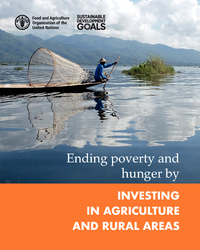Toward zero hunger and poverty, FAO publication on investing in agriculture and rural areas

The world has made unprecedented achievements in reducing poverty over the last three decades. But ending poverty and hunger by 2030 – and feeding an extra two billion people by 2050 – are still some of our greatest challenges. A new FAO publication sheds light on how investment in agriculture and rural development can offer a pathway out of poverty.
About 767 million people continue to live in extreme poverty today, with roughly two-thirds residing in rural areas.
In the last 30 years, private and public investments in agriculture and rural areas have stagnated or declined in most developing countries, particularly in sub-Saharan Africa and South Asia, where poverty and hunger are most prevalent.
By adopting the new 2030 Agenda for Sustainable Development, countries have renewed their commitment to fight poverty, hunger and malnutrition. They recognize that equitable growth and inclusive structural transformation are key to achieving sustainable development and lifting people out of poverty.
The 2030 Agenda is an opportunity to focus public and private investments in reaching the poorest of the poor. This is not a simple task. It requires a change in the way we think and act in relation to rural development.
While each country and region will have to evaluate its own pathways out of poverty, experience shows that economic growth alone – for example, in agriculture – is not enough.
Reducing poverty also requires investing in rural non-farm economies, strengthening rural institutions and organizations and expanding coverage of social protection, basic infrastructure and public services.
A combination of social and economic policies can create the necessary positive climate for family farmers, small-scale producers and poor rural people to earn a living, invest in their businesses and build sustainable livelihoods.
Related Links: FAO and the Sustainable Development Goals
